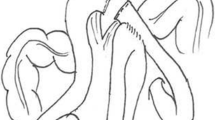Abstract
Background
Marginal ulcer (MU) is an occasional complication after gastric bypass. We studied the incidence of this complication by a prospective routine endoscopic evaluation.
Methods
441 morbidly obese patients were studied prospectively. There were 358 women and 97 men, with mean age 41 years and mean BMI 43 kg/m2. An endoscopic evaluation was performed in all 1 month after surgery, which was repeated in 315 patients (71%) 17 months after surgery, independent of the presence or absence of symptoms. Patients were submitted either to laparotomic resectional gastric bypass (360 patients), employing a circularstapler-25 or to laparoscopic gastric bypass (81 patients), in whom a hand-sewn anastomosis was performed.
Results
One month after surgery, 15 patients (4.1%) of the 360 laparotomic gastric bypass and 10 (12.3%) of the 81 laparoscopic gastric bypass presented an “early” marginal ulcer (p < 0.02). Seven patients among the 25 with MU were asymptomatic (28%). Endoscopy was repeated 17 months after surgery. Among 290 patients with no early MU, one patient (0.3%) presented a “late” MU 13 months after surgery. From the 25 patients with “early” MU, one patient (4%) presented a “late” MU. All these patients were treated with PPIs.
Conclusion
By performing prospective routine endoscopic study 1 month and 17 months after gastric bypass, two different behaviors were seen regarding the appearance MU: (a) “early” MU, 1 month after surgery in mean 6% and (b) “late” MU, in a very small proportion of patients (0.6%). Among patients with “early” MU, those who had undergone resectional gastric bypass showed significantly less ulcers compared to those patients in whom the excluded distal gastric segment had been left in situ. The operative method may play a significant role in the pathogenesis of MU after gastric bypass.
Similar content being viewed by others
References
Spaulding L. The impact of small bowel resection on the incidence of stomal stenosis and marginal ulcer after gastric bypass. Obes Surg. 1997;7:485–7.
Hedberg J, Hedenström H, Nilsson S, Sundbom M, Gustavsson S. Role of gastric acid in stomal ulcer after gastric bypass. Obes Surg. 2005;15:1375–8.
Rasnussen JJ, Fuller W. Marginal ulceration after laparoscopic gastric bypass: an analysis of predisposing factors in 260 patients. Surg Endosc. 2007;21:1090–4.
Csendes A, Burdiles P, Papapietro K, Díaz JC, Maluenda F, Burgos AM, et al. Results of gastric bypass plus resection of the distal excluded gastric segment in patients with morbid obesity. J Gastrointest Surg. 2005;9:121–31.
Dallal RM, Bailey LA. Ulcer disease after gastric bypass surgery. Surg Obes Relat Dis. 2006;2:455–9.
Sapala JA, Wood MH, Sapala MA, Flake TM. Marginal ulcer after gastric bypass: a prospective 3-years study of 173 patients. Obes Surg. 1998;8:505–16.
Gumbs AA, Duffy AJ, Bell RL. Incidence and management of marginal ulceration after laparoscopic Roux-en-Y gastric bypass. Surg Obes Relat Dis. 2006;2:460–3.
MacLean LD. Gastro-gastric fistulas and marginal ulcers in gastric bypass procedures for weight reduction. Obes Surg. 1999;9:28.
Capella JF, Capella RF. Gastro-gastric fistulas and marginal ulcers in gastric bypass procedures for weight reduction. Obes Surg. 1999;9:22–7.
Pope CD, Goodney PP, Burchard KW, Proia RR, Olafsson A, Larcy BE, et al. Peptic ulcer/stricture after gastric bypass: a comparison of technique and acid suppression variables. Obes Surg. 2002;12:30–3.
Smith CS, Herkes SB, Behrns KB. Gastric acid secretion and vitamin B12 absorption after vertical Roux-en-Y gastric bypass for morbid obesity. Ann Surg. 1993;218:91–6.
Behrns KE, Smith CD, Sarr MG. Prospective evaluation of gastric acid secretion and cobalamin absorption following gastric bypass for clinically severe obesity. Dig Dis Sci. 1999;39:315–20.
Lublin M, McCoy M, Waldrep DJ. Perforating marginal ulcers after laparoscopic gastric bypass. Surg Endosc. 2006;20:51–4.
Chin EH, Hazzan D, Sarpell U, Herron DM. Laparoscopic repair of a perforated marginal ulcer 2 years after gastric bypass. Surg Endosc. 2007;21:1007.
Author information
Authors and Affiliations
Corresponding author
Rights and permissions
About this article
Cite this article
Csendes, A., Burgos, A.M., Altuve, J. et al. Incidence of Marginal Ulcer 1 Month and 1 to 2 Years After Gastric Bypass: A Prospective Consecutive Endoscopic Evaluation of 442 Patients with Morbid Obesity. OBES SURG 19, 135–138 (2009). https://doi.org/10.1007/s11695-008-9588-6
Received:
Accepted:
Published:
Issue Date:
DOI: https://doi.org/10.1007/s11695-008-9588-6




